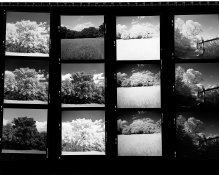Hi Paul,
I haven't got around to scan individual frames from that test, let alone making a real contact sheet or test prints as I still haven't got access to the darkroom.
I have a lo-fi contact sheet made with my phone putting the negative sleeve on a light table, though. Photo is reversed from the negative but otherwise not adjusted.
I can give you some details (frame 1 is in the lower left corner, frame 12 is upper right). Film is Rollei IR 400, shot at box speed when not using IR filter (Chinese one). Developed with HC-110 dil B for 8' at 20 degrees.
Metered against a gray card with my Minolta Spot Meter, around 5PM in UK. Sky was as blue as it gets in England.
Camera is Hasseblad 501C/M with Distagon 50 CFE, with lens hood. Focus at infinity (forgot to correct for IR, but it's probably not relevant, I was shooting stopped down to f11 or f16), on a tripod.
Big tree, sun behind me:
#1: no filter
#2: IR filter @25
#3: IR filter @12
#4: IR filter @6
#5: red filter (+3 stop from box speed)
Trees in the distance, sun at 90 degrees, looking north.
#6 :no filter
#7: IR filter @25
#8: IR filter @12
#9: IR filter @6
Fence and trees, with lots of shade. Sun at 90 degrees, looking north (very close to the shot that started this thread)
#10 IR filter @25
#11 IR filter @12
#12 IR filter @6
Hope this helps.
View attachment 247706


 . It's the only way for me to reconcile my earlier statement with the evidence staring me in the face.
. It's the only way for me to reconcile my earlier statement with the evidence staring me in the face. 


